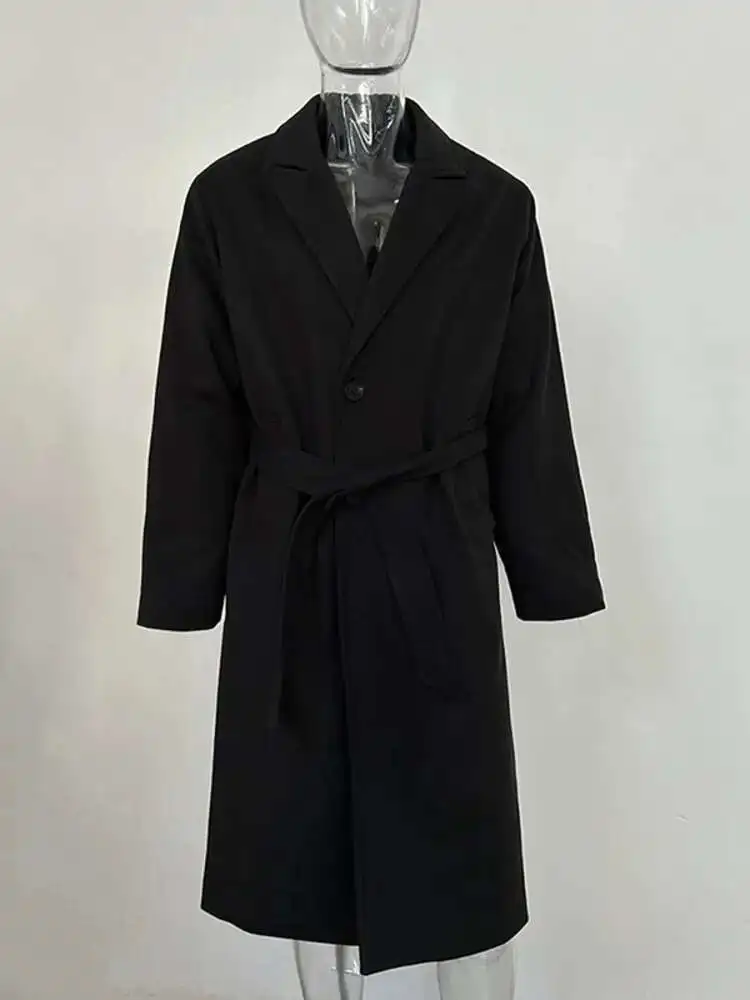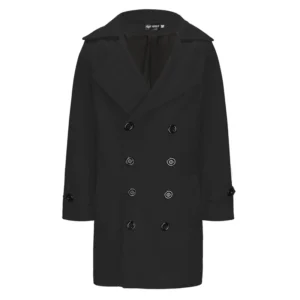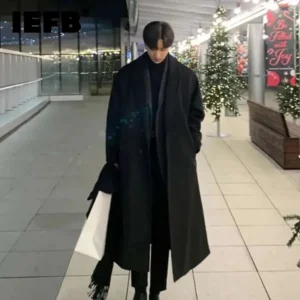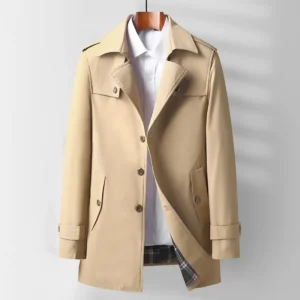Understanding the Timeless Appeal of Herringbone Wool Coats
The herringbone pattern stands as one of menswear’s most distinguished textures—a sophisticated V-shaped weave that brings depth and character to outerwear. This distinctive pattern, characterized by its zigzag appearance, has been gracing fine men’s clothing for generations, originating from the textile traditions of British tailoring. What makes herringbone particularly special is its remarkable versatility—it manages to be both statement-making and understated simultaneously.
A quality herringbone wool coat represents more than just winter protection; it’s an investment piece that bridges formal and casual wardrobes seamlessly. The pattern’s subtle complexity adds visual interest without overwhelming an outfit, making it appropriate for everything from business meetings to weekend outings. The choosing right coat length significantly impacts how your herringbone coat balances proportion and style in your overall look.
The enduring popularity of herringbone speaks to its timeless appeal—neither too trendy nor too conservative, it occupies that perfect middle ground of refined style. Understanding the herringbone coat pattern helps appreciate why these coats remain relevant through changing fashion trends. This guide will walk you through everything from selecting the perfect herringbone coat to styling it across multiple occasions and seasons.
For those ready to explore options, our collection of men’s herringbone coats offers various interpretations of this classic pattern.
Essential Features of a Quality Herringbone Wool Coat
A distinguished herringbone coat begins with its characteristic pattern—a series of parallel lines that create a V-shaped zigzag effect resembling fish bones (hence the name). This pattern can vary dramatically in scale: fine herringbone creates a more subtle, sophisticated appearance suitable for formal settings, while bold, pronounced patterns make more of a statement and often work beautifully in casual contexts.
The color palette of herringbone coats typically centers around neutrals, each offering distinct styling possibilities:
- Gray/Charcoal: The most versatile option, pairing effortlessly with virtually any color
- Brown/Camel: Adds warmth and pairs excellently with earth tones and blues
- Navy: Offers a softer alternative to black while maintaining formality
- Black: Provides maximum formality and sharpness, especially in evening settings
Herringbone coats come in several classic silhouettes, each with different styling implications:
- Single-breasted: Most versatile for both formal and casual wear
- Double-breasted: Projects authority and formality, ideal for business settings
- Chesterfield: Features a velvet collar for a touch of refined elegance
Fabric weight significantly affects both function and styling potential. Lighter herringbone wool (around 14-16 oz) offers versatility for mild climates and layering, while heavier weights (18-24 oz) provide substantial warmth for winter conditions but limit seasonal versatility.
Quality indicators worth noting include horn or high-quality corozo buttons, hand-stitched details particularly around lapels, and superior lining materials like silk or high-grade viscose. Understanding different coat length options helps ensure your herringbone coat complements your body proportions and style needs.
For those seeking exceptional quality, our selection of men’s wool overcoats includes various herringbone options crafted to exacting standards.
Finding Your Perfect Fit: The Foundation of Great Style
The perfect fit forms the cornerstone of a well-styled herringbone coat. Even the finest materials and craftsmanship cannot compensate for poor fit. When evaluating fit, focus on these critical areas:
- Shoulders: The seam should align precisely with your natural shoulder edge—neither extending beyond nor falling short
- Chest: When buttoned, the coat should allow enough room for a suit or sweater underneath without pulling at the buttons
- Length: A classic overcoat should fall between mid-thigh and just above the knee; determining the perfect coat length for height ensures balanced proportions
- Sleeves: Should end at the base of your thumb when arms are relaxed, allowing roughly ¼ to ½ inch of suit jacket sleeve to show
Herringbone coats present special fit considerations, particularly pattern alignment. On a quality coat, the herringbone pattern should match at the seams, particularly across the shoulders and down the center back.
Common fit mistakes to avoid include:
– Shoulders extending beyond your natural shoulder line
– Collar gapping away from the neck when buttoned
– Restricted arm movement that causes the entire coat to shift
– Excessive fabric pooling at the shoulders or chest
Minor alterations like sleeve length and button repositioning can significantly improve fit, but structural changes to shoulders or chest are complex and costly—often signaling you should try a different size or cut altogether. Browse our selection of men’s overcoats to find options in various fits and sizes.
Formal and Business Styling: Herringbone in Professional Settings
The herringbone wool coat truly excels in formal and business environments, adding sophistication to professional attire. For maximum impact in these settings, consider these styling approaches:
When pairing with suits, follow these color coordination principles:
– Gray herringbone harmonizes beautifully with navy, charcoal, or black suits
– Brown herringbone complements navy, tan, and olive suits
– Navy herringbone works well with gray, charcoal, or brown suits
For formal shirt and tie combinations:
– Light blue or white shirts provide a clean backdrop for the textured coat
– Solid or subtly patterned ties work best, allowing the herringbone pattern to remain prominent
– Consider burgundy, navy, or forest green ties to add a touch of color while maintaining professionalism
Appropriate formal footwear includes:
– Oxford shoes in black or dark brown for maximum formality
– Polished derby shoes for slightly more relaxed business settings
– Monk straps in coordinating leather for a touch of distinctive style
To maintain the right formality balance, remember that the inherent texture of herringbone naturally makes it slightly less formal than a solid coat. Compensate by ensuring other elements of your outfit remain crisp and refined. This makes our men’s dress coat collection an excellent complement to your formal wardrobe.
Smart-Casual Office Styling: Versatile Business Casual Looks
The herringbone coat truly shines in smart-casual business environments, where its textured pattern adds character while maintaining professionalism. This middle ground between formal and casual represents the coat’s versatility sweet spot.
For business casual settings, consider these refined combinations:
- Gray herringbone coat paired with a navy blazer, light blue Oxford shirt, and charcoal trousers
- Brown herringbone coat over a cream turtleneck, olive chinos, and chocolate brown brogues
- Navy herringbone coat complementing a gray cashmere sweater, white shirt, and dark jeans
When incorporating knitwear, fine gauge sweaters in merino or cashmere maintain a polished appearance while adding warmth. Turtlenecks offer a particularly sophisticated option that eliminates the need for a scarf in milder conditions.
Footwear for business casual settings can include:
– Brogues or semi-brogues in brown or burgundy
– Chelsea boots in smooth leather
– Loafers in suede or leather for warmer days
The versatility between formal and casual settings makes herringbone coats particularly valuable for professionals who navigate varying dress codes. This adaptability ensures your herringbone coat earns its place as a wardrobe workhorse rather than an occasional piece.
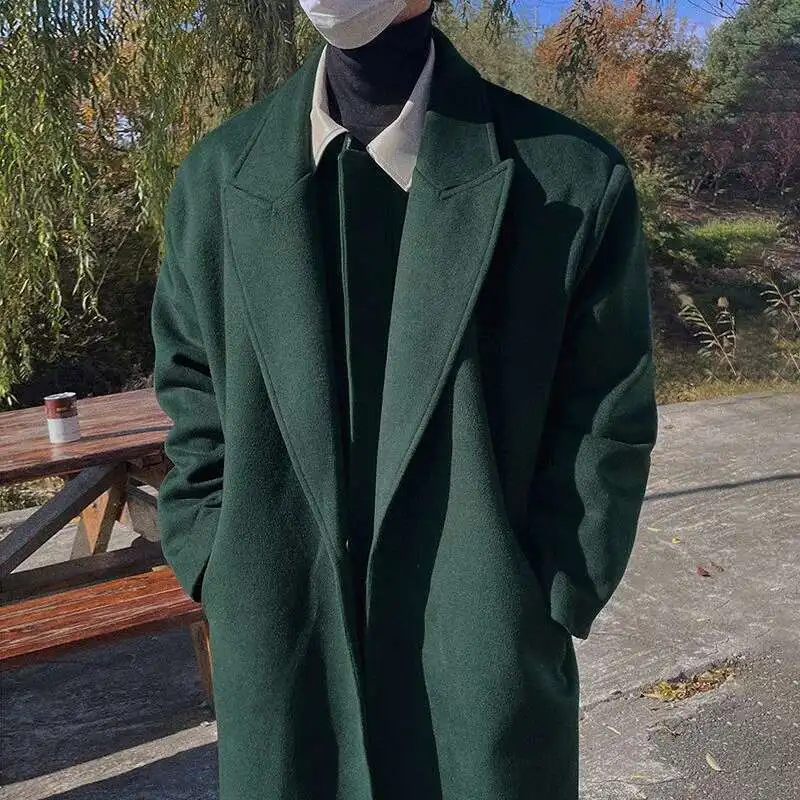
Weekend and Casual Styling: Refined Off-Duty Looks
The sophisticated texture of a herringbone coat can elevate even the most casual weekend attire, creating that coveted “effortlessly refined” aesthetic. The key to casual herringbone styling lies in balanced contrasts—pairing the coat’s formality with intentionally relaxed pieces.
Consider these weekend-ready combinations:
– Brown herringbone coat with raw selvedge denim, a cream cable-knit sweater, and suede chukka boots
– Gray herringbone coat layered over a flannel shirt, charcoal henley, black jeans, and leather boots
– Navy herringbone coat paired with olive chinos, a light gray sweatshirt, and clean white sneakers
When incorporating denim, opt for darker washes and well-fitted cuts—the structure complements the coat’s tailored nature while maintaining casual appeal. Avoiding distressed or overly casual denim preserves the sophisticated balance.
Casual shirting options that pair beautifully include:
– Oxford cloth button-downs in solid colors or subtle patterns
– Chambray shirts in blue or gray tones
– Flannel shirts in muted plaids or solid colors
For footwear, consider:
– Clean, minimalist sneakers in white, gray, or navy
– Desert boots or chukkas in suede
– Casual leather boots with minimal hardware
Understanding the differences between short vs long coats helps determine which style works best for your casual looks. Generally, shorter coats (car coats, pea coats) lean more casual while longer overcoats create a more dramatic silhouette.
Mastering Layering Techniques for Style and Warmth
Strategic layering with a herringbone coat accomplishes two crucial goals: creating visual depth through texture contrasts and providing practical warmth that can be adjusted throughout the day. The coat’s structured nature makes it an ideal outer layer that maintains shape even with multiple layers beneath.
For effective layering, follow these principles:
- Start thin, build outward: Begin with lightweight, breathable fabrics against the skin and increase bulk with each layer
- Maintain proportions: Each visible layer should be longer than the one above it (shirt longer than sweater, sweater longer than jacket)
- Create texture contrasts: Pair smooth with rough, fine with chunky (smooth merino under textured herringbone)
Optimal layering combinations include:
– Fine cotton shirt → cashmere sweater → herringbone coat
– Cotton turtleneck → lightweight jacket → herringbone coat
– Oxford shirt → knit cardigan → herringbone coat
To avoid excessive bulk, select slim-fitting inner layers and ensure each piece fits properly on its own. This approach provides warmth without sacrificing the clean lines of your coat length and style.
For temperature flexibility, consider a coat from our men’s wool coats collection that offers substantial warmth while maintaining a refined silhouette.
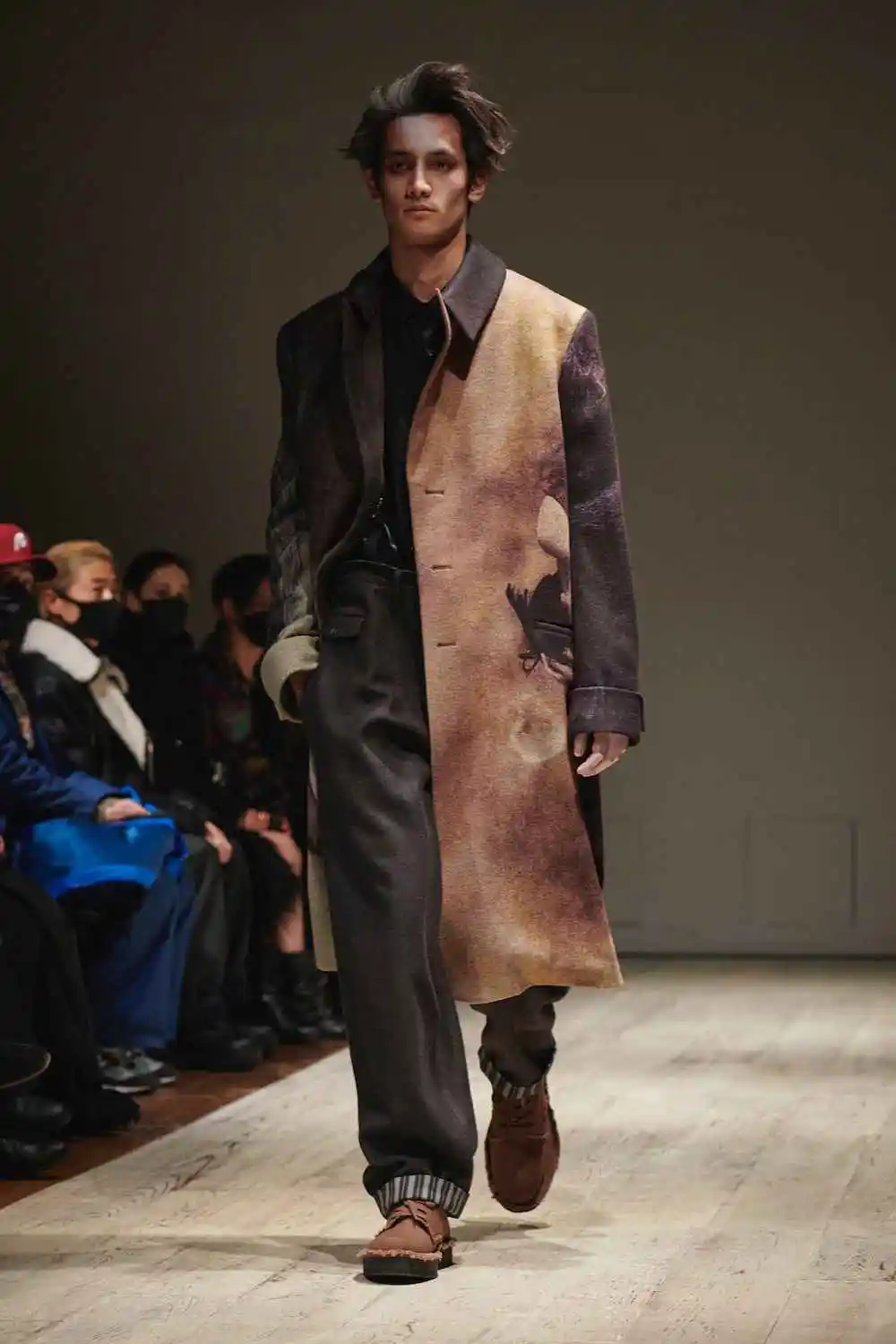
Essential Accessories: Elevating Your Herringbone Coat
The right accessories can transform a herringbone coat outfit, adjusting its formality and expressing personal style. Given the coat’s textured pattern, accessories provide opportunities for both complementing and contrasting elements.
For scarf selections:
– Solid cashmere or wool scarves in complementary colors (burgundy, forest green, camel)
– Subtle patterns that don’t compete with herringbone (small checks, solid textures)
– Lighter weight options for milder weather, chunky knits for winter
Hat options to consider:
– Fedoras or trilbies in coordinating wool for formal settings
– Flat caps or newsboy caps for a heritage-inspired look
– Simple beanies in fine wool or cashmere for casual wear
Glove choices that maintain the coat’s sophistication:
– Leather gloves (lined for warmth) in brown or black for formal settings
– Leather and knit combination gloves for versatility
– Fine wool or cashmere gloves for casual outfits
For bags that complete the look:
– Leather briefcases for business settings
– Structured messenger bags in canvas and leather
– Minimal backpacks in premium materials for casual use
By thoughtfully selecting accessories, you can create numerous variations from the same base outfit, effectively expanding your wardrobe. For inspiration, browse our collection of herringbone overcoat outfit ideas showcasing accessory pairings.
Mens Double Breasted Pea Coat, Mens Wool Blend Coat, Mens Wool Pea Coat
Price range: $136.84 through $157.36 Select options This product has multiple variants. The options may be chosen on the product pageMens Cashmere Overcoat, Mens Hooded Winter Coat, Mens Wool Blend Coat
Price range: $128.72 through $139.68 Select options This product has multiple variants. The options may be chosen on the product pageMens Black Overcoat, Mens Black Wool Coat, Mens Wool Overcoat
$339.18 Select options This product has multiple variants. The options may be chosen on the product pageMens Grey Overcoat, Mens Wool Blend Coat, Mens Wool Overcoat
$201.28 Select options This product has multiple variants. The options may be chosen on the product pageMens Herringbone Coat, Mens Long Overcoat, Mens Wool Overcoat
Price range: $197.16 through $203.69 Select options This product has multiple variants. The options may be chosen on the product pageMens Long Overcoat, Mens Topcoats
Price range: $189.40 through $196.88 Select options This product has multiple variants. The options may be chosen on the product page
Footwear Pairings: The Right Shoes for Every Occasion
The right footwear anchors your herringbone coat styling, setting the formality level and completing the overall aesthetic. Consider these footwear categories and how they pair with your herringbone coat:
Formal Options
– Oxford shoes: The closed lacing system creates a sleek silhouette perfect for business and formal events
– Whole-cut shoes: The seamless upper offers maximum elegance for formal occasions
– Monk straps: Provide a distinctive touch for business settings while maintaining formality
Smart-Casual Selections
– Derby shoes: Open lacing creates a slightly more relaxed appearance than Oxfords
– Brogues: Decorative perforations add visual interest while maintaining refinement
– Chelsea boots: Sleek, ankle-height boots with elastic side panels work beautifully under longer coats
Casual Pairings
– Desert boots or chukkas: Ankle-height suede options that bridge casual and smart-casual
– Minimal leather sneakers: Clean designs in quality materials maintain sophistication
– Leather boots: Rugged options with minimal hardware for weekend wear
For color coordination, follow these principles:
– Match leather shoes to leather accessories (belts, gloves) when possible
– Brown footwear pairs naturally with brown, gray, and navy herringbone
– Black footwear creates a sharper look with charcoal, gray, or navy herringbone
Color Theory: Creating Harmonious Outfits with Herringbone
Understanding color relationships helps create cohesive outfits with your herringbone coat. The pattern typically combines two colors in its weave, providing natural coordination opportunities.
For gray herringbone coats:
– Navy, burgundy, and forest green create classic combinations
– Pastels (light blue, lavender) offer sophisticated spring options
– Black and white create high-contrast, dramatic looks
For brown herringbone coats:
– Forest green, mustard, and burgundy complement beautifully
– Blue tones (from navy to light blue) create appealing contrasts
– Cream and off-white lighten and brighten the earth tones
For navy herringbone coats:
– Gray, burgundy, and camel form reliable companions
– Olive green creates a rich, sophisticated palette
– White and cream provide crisp contrast
When building outfits, consider these approaches:
– Tonal: Using varying shades of the same color family for subtle sophistication
– Complementary: Pairing colors from opposite sides of the color wheel for vibrant contrast
– Analogous: Using colors adjacent on the color wheel for harmonious combinations
For expert guidance on color selection, our guide to best colors for herringbone coats provides deeper insights into creating perfect combinations.
Can Herringbone Coats Work for Special Occasions?
Herringbone coats certainly have their place at special events, particularly those held during colder months. The key lies in selecting the right herringbone pattern and styling it appropriately for the occasion’s formality level.
For formal evening events:
– Choose finer, more subtle herringbone patterns in darker colors
– Pair with formal evening wear including black tie when appropriate
– Ensure impeccable fit and condition of the coat
A herringbone overcoat works particularly well for:
– Winter weddings (especially daytime or less formal evening celebrations)
– Theater or symphony performances
– Upscale restaurant dinners
– Gallery openings and museum events
To elevate your herringbone coat for special occasions:
– Add a dress scarf in silk or fine wool
– Consider elegant leather gloves
– Ensure shoes are perfectly polished
– Add subtle metallic accessories like cufflinks or tie bars
For the most formal black-tie events, a solid black overcoat traditionally prevails as the safest choice. However, a dark, subtle herringbone can work beautifully as a sophisticated alternative when executed with confidence.

How Should I Care for My Herringbone Wool Coat?
Proper care ensures your herringbone wool coat remains an investment piece for years. Follow these essential maintenance practices:
For cleaning and freshening:
– Brush the coat regularly with a soft clothes brush, following the direction of the fabric
– Spot clean small stains immediately using a damp cloth and mild soap
– Dry clean only when necessary (ideally once per season) to prevent premature wear
– Air out the coat after wearing by hanging it on a proper wooden hanger
For storage during off-seasons:
– Clean the coat thoroughly before storing
– Use a high-quality wooden or padded hanger to maintain shoulder shape
– Cover with a breathable garment bag (avoid plastic which traps moisture)
– Add cedar blocks or lavender sachets as natural moth repellents
– Store in a cool, dry closet away from direct sunlight
For maintaining appearance:
– Steam rather than iron to remove wrinkles
– Use a lint roller regularly to keep the surface clean
– Address minor pills with a fabric shaver designed for wool
– Have small repairs addressed promptly before they worsen
Professional care is recommended for:
– Significant stains or odors
– Structural repairs to lining or seams
– Annual end-of-season cleaning before storage
Is Herringbone Suitable for All Seasons?
While traditionally associated with fall and winter, herringbone coats can extend their wearability across more seasons than you might expect, particularly when considering fabric weight and styling approach.
For traditional fall/winter wear:
– Embrace full layering potential with sweaters and scarves
– Take advantage of the pattern’s ability to hide light precipitation marks
– Pair with seasonal textures like flannel, tweed, and heavy knits
For transitional spring weather:
– Choose lighter weight herringbone options (under 18 oz)
– Layer over lightweight sweaters or shirts alone
– Pair with spring-appropriate colors like light blue, tan, or soft gray
For maximizing seasonal adaptability:
– Quarter-lined or half-lined coats offer greater temperature flexibility
– Adjust layers underneath rather than changing coats entirely
– Consider winter coat length when selecting a versatile option
While even the lightest herringbone wool coat becomes impractical for genuine summer weather, a well-chosen piece can serve you well from early fall through mid-spring in many climates.
What Are the Most Common Herringbone Styling Mistakes to Avoid?
Even with a quality herringbone coat, certain styling missteps can undermine your look. Avoid these common pitfalls:
Pattern clashing mistakes:
– Combining herringbone with similarly scaled patterns (especially other herringbones)
– Pairing with bold, competing patterns like large plaids or checks
– Using too many patterns in one outfit (limit to two, with one significantly more subtle)
Proportion problems:
– Wearing a long overcoat with short jackets that peek out underneath
– Choosing a coat that’s too voluminous for your frame
– Pairing slim bottoms with an excessively boxy coat
Formality mismatches:
– Wearing a structured herringbone coat with very casual items like graphic t-shirts or athletic wear
– Pairing fine herringbone with rugged workwear (conflicting messages)
– Using overly casual accessories with a formal herringbone coat
Accessory errors:
– Overloading with accessories that compete with the pattern
– Choosing accessories in clashing materials (like synthetic fabrics with wool)
– Neglecting seasonal appropriateness of accessories
For additional refined outerwear options, our selection of men’s tweed coats offers complementary alternatives to herringbone that follow many of the same styling principles.
By avoiding these common mistakes and applying the guidance throughout this guide, your herringbone wool coat will serve as a versatile cornerstone of your wardrobe, elevating outfits across numerous contexts and occasions.

